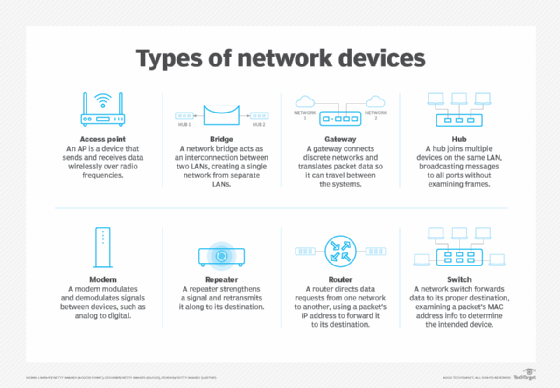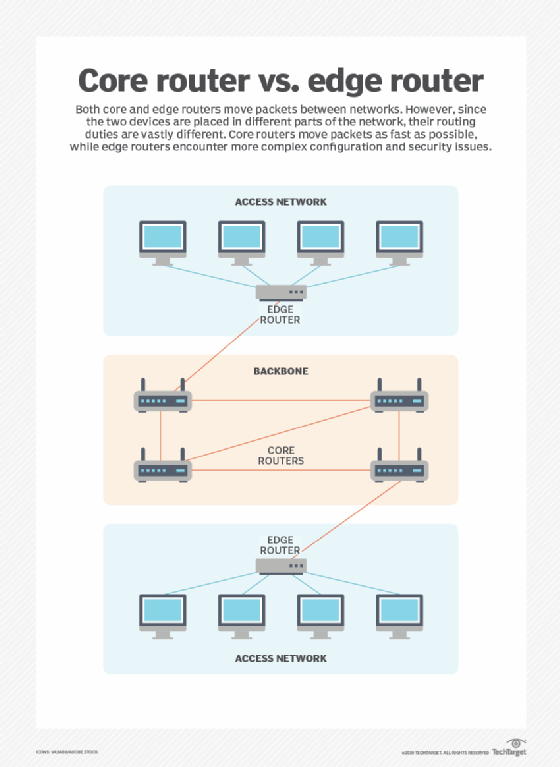
Getty Images/iStockphoto
Common types of networking devices explained
This introduction explores eight network devices that are commonly used within enterprise network infrastructures, including access points, routers and switches.
Networking doesn't work without the physical and virtual devices that make up the network infrastructure.
Network architecture varies based on size, network topology, workloads and business requirements, among other factors. For example, an enterprise network might require hundreds or thousands of various network devices to support and build out its data center, LAN and WAN. In contrast, a simple home network might need only two devices.
Below are eight common types of network devices -- excluding load balancers and firewalls -- that are typically found within networks.
1. Access point
An access point (AP) is a device that sends and receives data wirelessly over radio frequencies, using 2.4 GHz or 5 GHz bands. Clients, such as laptops or mobile phones, connect to an AP using a wireless signal, enabling them to join the wireless LAN created by the AP. An Ethernet cable physically connects the AP to a router or switch in a wired LAN, which provides the AP with access to the internet and the rest of the network.
When deploying APs, wireless teams must consider factors like location, attenuation and channel interference, all of which can affect signal strength. Typically, engineers mount APs on ceilings or walls to maximize signal coverage and minimize potential obstacles.
APs operate at Layer 2 of the OSI model -- the data link layer.
2. Bridge
A network bridge acts as an interconnection between two or more LANs, essentially creating a single domain from separate LANs. In this way, a bridge is different than a router, which enables communication among different networks but considers them discrete systems.
A bridge aggregates the partitioned network segments and controls traffic that moves between them. A transparent bridge interconnects LANs that use the same protocol suite, while a translation bridge joins LANs that use different protocols.
Bridge devices have switching capabilities, with which they forward incoming data frames by examining media access control (MAC) addresses. With each frame it receives, a bridge builds a lookup table of MAC addresses and port locations. The bridge references this table to determine whether to forward a frame along or discard it, which happens when a MAC address is not within the bridge's domain.
Bridges are no longer commonly used within enterprise network designs and are typically replaced by switches.
A bridge operates at Layer 2 of the OSI model.

3. Gateway
A gateway is a network node that connects discrete networks or systems that use different protocols, enabling data to flow between the networks. Gateways use multiple protocols and translate an incoming packet's information and protocol to make it compatible with the destination environment. After a gateway processes the data packet, it typically forwards it on to a router, which sends the packet toward its destination within the network.
Types of gateways include routers, web application firewalls and email security gateways. Gateways are also frequently used within IoT and cloud environments.
Gateways can operate at any layer of the OSI model.
4. Hub
A hub is a physical device used to join multiple devices on the same LAN. For example, a laptop, desktop computer and printer can connect into a hub's ports with Ethernet cables and be part of the same local network. Unlike a bridge, router or switch, a hub broadcasts messages it receives from one port to all remaining ports without examining the frames or isolating the message for the intended destination.
A hub must connect to a router or switch in order to communicate outside its LAN. Hub devices can also connect to each other to expand the overall network.
A hub can be active, passive or intelligent. Active hubs act as repeaters to boost or repair the signal of an incoming message before they broadcast it to the rest of the ports. Passive hubs do not boost message signals, simply providing connectivity for devices on its ports. Intelligent hubs have management and monitoring capabilities to identify potential issues with connected devices.
A hub operates at Layer 1 of the OSI model -- the physical layer.
5. Modem
The main purpose of a modem is to modulate and demodulate -- or convert -- signals between devices, such as analog to digital. Nowadays, the most common type of modem is an internet modem, which facilitates internet access by receiving signals from an ISP and converting them into a format that connected devices can use, such as radio or digital signals.
A modem typically connects to a router, which receives internet access from the modem and sends it to other devices on the network. Modems can use Ethernet cable, DSL, fiber or wireless mediums for connectivity. ISPs frequently provide modems that have combined routing and firewalling capabilities.
Depending on the type, a modem operates at Layer 1 or Layer 2 of the OSI model.
6. Repeater
A repeater strengthens a signal and resends it to its destination. Repeaters are used to combat attenuation, bypass interference and extend the range of a signal. They are commonly used within wireless networks but also work with fiber optics, telephones and TV broadcasting, among others.
While a hub boosts signals for multiple devices connected to its ports, a simple repeater has only two ports -- one for incoming signals and one for outgoing signals.
A repeater operates at Layer 1 of the OSI model.
7. Router
A router directs data requests from one network to another. Routers examine incoming packets to determine the appropriate destination IP address and then forward the packet to that destination. A router can also enable internet access through its connection to a modem, or as a combined modem-router.
As with a bridge, routers maintain and use routing tables that contain route information, such as IP addresses and interfaces. Once a router inspects a packet, it refers to the routing table to find the best path toward the destination. Routers use routing protocols to communicate and exchange data.
Types of routers typically used in enterprise networks include the following:
- Edge routers.
- Core routers.
- Distribution routers.
- Wireless routers.
A router operates at Layer 3 of the OSI model -- the network layer.

8. Switch
A network switch forwards data to its destination by examining an incoming frame's MAC address and sending it to the device with the matching address.
Devices connect into a switch's ports usually via an Ethernet cable. The switch stores those devices' MAC addresses in an address table it uses as a reference when transferring frames. While a router forwards data to an IP address or network, a switch sends the information directly to the specific destination port.
Unlike a hub, which shares bandwidth among all its ports, a switch allocates bandwidth for each port. Switches are also more intelligent than hubs, as they examine an incoming frame's MAC address.
Switches are available in the following types:
- Unmanaged switches.
- Managed switches.
- Smart switches.
- Layer 2 switches.
- Layer 3 switches.
- Power over Ethernet switches.
- Fixed switches.
- Stackable switches.
- Modular switches.
A traditional switch operates at Layer 2 of the OSI model. Layer 3 switches operate at the network layer and transfer packets based on the destination IP address.








